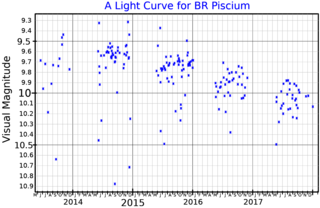Gliese 1 is a red dwarf in the constellation Sculptor, which is found in the southern celestial hemisphere. It is one of the closest stars to the Sun, at a distance of 14.2 light years. Because of its proximity to the Earth it is a frequent object of study and much is known about its physical properties and composition. However, with an apparent magnitude of about 8.6 it is too faint to be seen with the naked eye.
Gliese 674(GJ 674) is a small red dwarf star with an exoplanetary companion in the southern constellation of Ara. It is too faint to be visible to the naked eye, having an apparent visual magnitude of 9.38 and an absolute magnitude of 11.09. The system is located at a distance of 14.8 light-years from the Sun based on parallax measurements, but is drifting closer with a radial velocity of −2.9 km/s. It is a candidate member of the 200 million year old Castor stream of co-moving stars.
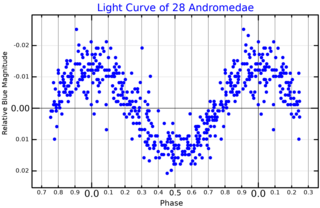
28 Andromedae is a Delta Scuti variable star in the constellation Andromeda. 28 Andromedae is the Flamsteed designation. It also bears the variable star name GN Andromedae. Its apparent magnitude is 5.214, varying by less than 0.1 magnitudes.

9 Aurigae is a star system in Auriga (constellation). It has an apparent magnitude of about 5, making it visible to the naked eye in many suburban skies. Parallax estimates made by the Hipparcos spacecraft put it at about 86 light-years from the solar system, although individual Gaia Data Release 3 parallaxes place all three components at 88 light years.
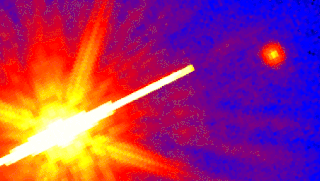
Gliese 105 is a triple star system in the constellation of Cetus. It is located relatively near the Sun at a distance of 23.6 light-years. Despite this, even the brightest component is barely visible with the unaided eye (see Bortle scale). No planets have yet been detected around any of the stars in this system.
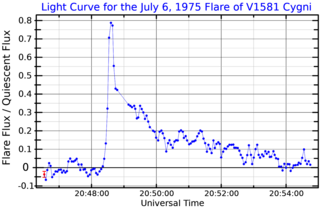
GJ 1245 is a double star with components G 208-44 and G 208-45, 14 light-years away, relatively close to the Solar System. G 208-44 is itself a closer double star made up of two red dwarfs, while G 208-45 is also a red dwarf. GJ 1245 is the 37th closest stellar system to the Solar System, located in the constellation Cygnus. GJ 1245 A and B are active flare stars, and the pair are collectively designated V1581 Cygni.

HD 155035 is a star in the constellation Ara, the Altar. It is located at a distance of approximately 1,450 light-years from Earth and has an apparent visual magnitude of 5.92, making it is faintly visible to the naked eye. This is a red giant star with a stellar classification of M1.5 III. It an irregular variable that changes brightness over an amplitude range of 0.12 magnitudes.
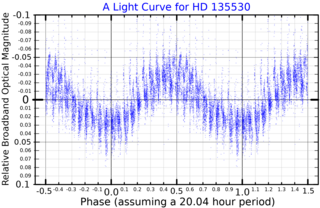
HD 135530 is a suspected variable star in the northern constellation of Boötes.
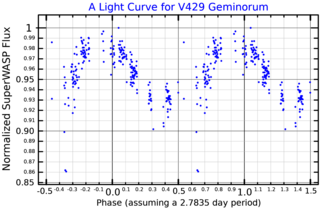
V429 Geminorum (BD+20°1790) is a young orange dwarf star in the constellation Gemini, located 90 light years away from the Sun. It is a BY Draconis variable, a cool dwarf which varies rapidly in brightness as it rotates.
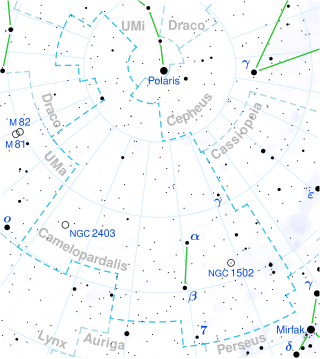
1 Camelopardalis is a double star system in the constellation Camelopardalis. Its combined apparent magnitude is 5.56 and it is approximately 800 parsecs (2,600 ly) away.
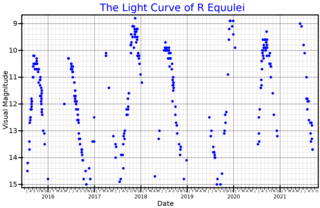
R Equulei is a class M Mira variable star in the constellation Equuleus. Its brightness varies between a minimum magnitude of 15.0 to a maximum of 8.7 with an average period of 261 days.
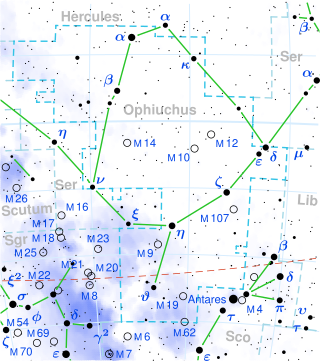
Sigma Ophiuchi, Latinized from σ Ophiuchi, is a single, orange-hued star in the equatorial constellation Ophiuchus. Its apparent visual magnitude is 4.31, which is bright enough to be faintly visible to the naked eye. The annual parallax shift of 3.62 mas as seen from Earth provides a distance estimate of roughly 900 light years. It is moving closer to the Sun with a radial velocity of −28 km/s.
Ross 47 is a variable star of spectral type M4 located in the constellation Orion, 19 light-years from Earth.
EQ Pegasi is a nearby binary system of two red dwarfs. Both components are flare stars, with spectral types of M4Ve and M6Ve respectively, and a current separation between the components of 5.8 arcseconds. The system is at a distance of 20.4 light-years, and is 950 million years old. The primary star is orbited by one known exoplanet.
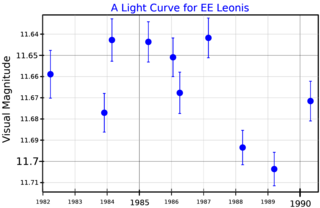
Gliese 402 is a star located 22.7 light years from the Solar System. Located in the constellation of Leo, it is also known as Wolf 358 from its entry in Max Wolf's star catalogue. The stars nearest to Gliese 402 are Gliese 393, at 3.43 light years, Gliese 408, at 6.26 light years, and Gliese 382 at 6.66 light years.
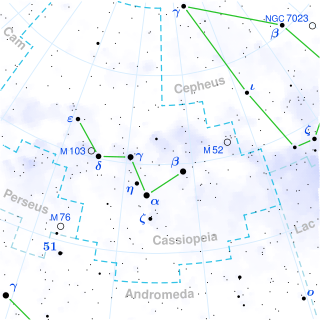
S Cassiopeiae is a Mira variable and S-type star in the constellation Cassiopeia. It is an unusually cool star, rapidly losing mass and surrounded by dense gas and dust producing masers.

DS Tucanae is a binary star system 144 light years away in the constellation of Tucana. It has an apparent visual magnitude of 8.5, and is a RS Canum Venaticorum variable. The system is notable for being young as a member of the 45 Myr old Tucana-Horologium moving group and for the primary star hosting the confirmed exoplanet DS Tucanae Ab, discovered by THYME, using TESS.
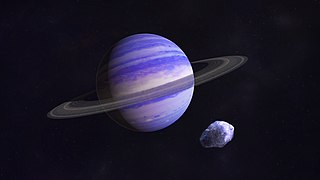
Gliese 15 Ac is an exoplanet orbiting the nearby red dwarf star Gliese 15 A, which is part of a binary star system located about 11.6 light-years from the Sun. The planet was first proposed in October 2017 using radial velocity data from the CARMENES spectrograph, combined with measurements from the HARPS and HIRES spectrographs, and its existence was confirmed in April 2018 using HARPS-N data. It has a minimum mass 36 times that of Earth and orbits at around 5.4 astronomical units with a period of 7,600 days, an orbit which may have been sculpted by interaction with the companion star, Gliese 15 B. As of 2020, Gliese 15 Ac is the longest-period sub-Jovian planet discovered by radial velocity.
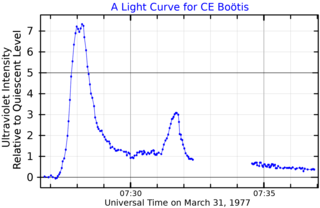
Gliese 569 is a ternary star system composed of a main-sequence star orbited by a pair of brown dwarfs in the constellation of Boötes about 32 light years away.
Gliese 514, also known as BD+11 2576 or HIP 65859, is a M-type main-sequence star, in the constellation Virgo 24.85 light-years away from the Sun. The proximity of Gliese 514 to the Sun was known exactly since 1988.
